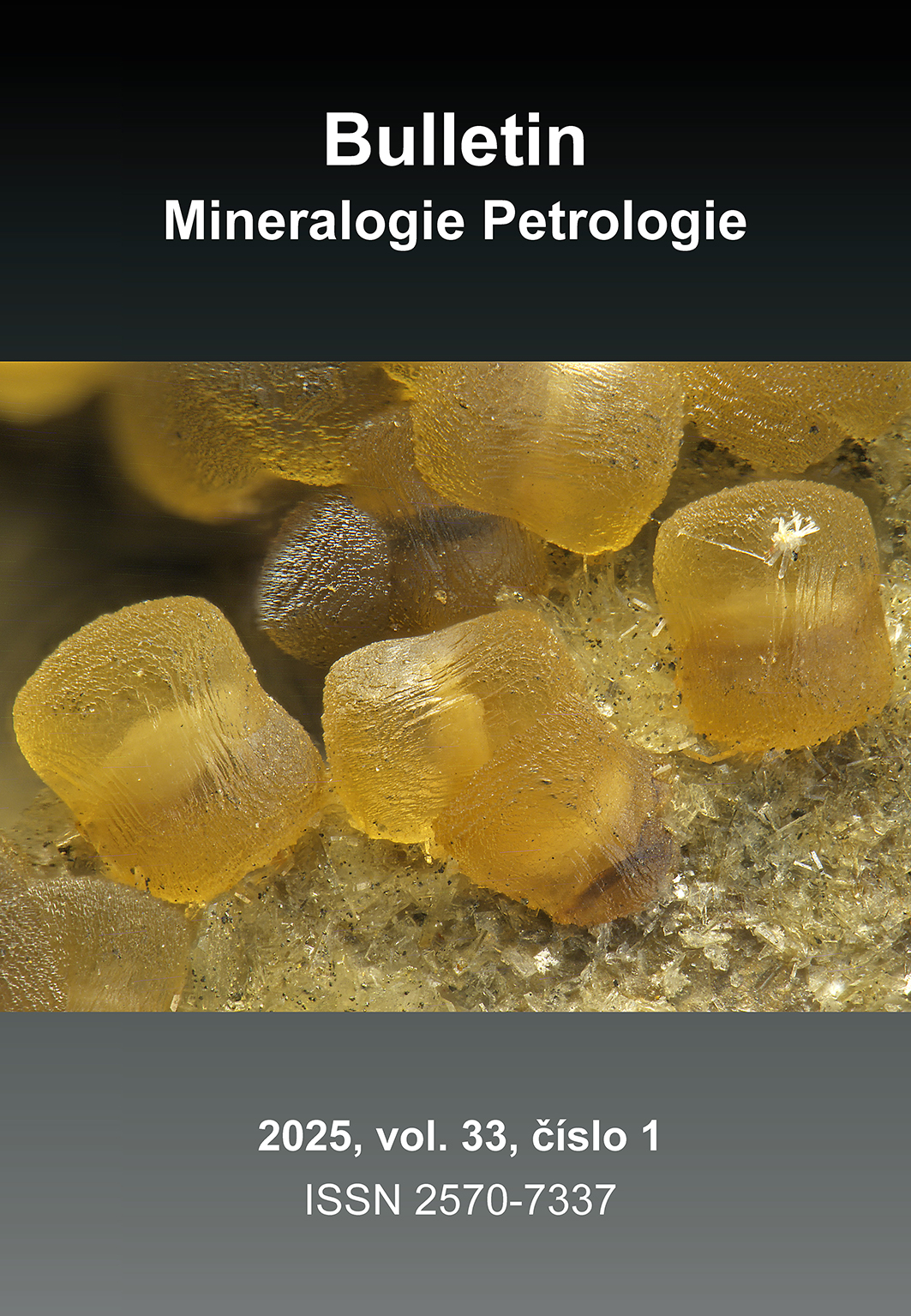Revision of harmotome from the Tertiary neovolcanite from Ostrava-Muglinov (Czech Republic)
Keywords
Abstract
From the Tertiary basaltoid rocks known from the mines and quarries in Ostrava city, harmotome was described in 1857 and phillipsite in 1928. Samples of both are very scarce and preserved only in museum collections in Ostrava and Brno. We were allowed to study sample from the Ostrava museum, where zeolite mineral occurred in amygdaloid cavity together with younger calcite. X-ray powder diffraction analysis proved its affiliation to the harmotome-phillipsite-Ca series. Its average chemical formula from WDS is (Ba1.85Ca0.32K0.14Na0.12Mn0.01)Σ2.44[Al4.90Si11.17]Σ16.07O32.00·13.05H2O. It belongs to the low temperature hydrothermal mineralization, typical for some Tertiary basaltoid rocks in the area of the Bohemian Massif.
Files
References
Akimoto T, Kinoshita H, Furuta T (1984) Electron probe microanalysis study on processes of low-temperature oxidation of titanomagnetite. Earth Planet Sci Lett 71: 263-278
Atanassova R, Vassileva RD, Kadiyski M, Zlatev Z (2012) Crystallographic, chemical and structural characteristics of harmotome from Zlatolist, Eastern Rhodopes, Bulgaria. Bulg Chem Commun 44: 7-16
Dvořák P, Dopita M (1968) Výskyt přírodních koksů v OKR. Sbor věd Prací Vys Šk báň v Ostravě, Ř horn-geol 14: 121-137
Folprecht J (1928) Výlevy čediče. In Kamenouhelné doly ostravsko-karvinského revíru 233-236. Ředitelská konference ostravsko-karvinského kamenouhelného revíru Moravská Ostrava
Jahn JJ (1908) O původu čedičových koulí na Jaklovci u Moravské Ostravy. 1-12, Ant. Odehnal Brno
Kittl E (1887) Die Miocenablagerungen des Ostrau-Karwiner Steikohlenreviers und deren Faunen. Ann K-kön Naturhist Hofmuseums 2: 217-282
Klvaňa J (1892) O eruptivních horninách tešenitových a pikritových na severovýchodní Moravě. Rozpr Čes Akad Věd Cís Františka Josefa Vědy, Slovesn. Umění, Tř 2 math-přírodn 1: 603-615
Králík J (1982) Mineralogie pestrých vrstev v ostravsko-karvinské černouhelné pánvi. Čas Slez Muz, Vědy přír 31: 149-171
Martinec P (1997) Vulkanismus v pánvi. In Dopita M (ed.) Geologie česká části hornoslezské pánve 153-159. Ministerstvo životního prostředí České republiky Praha
Niedzwiedzki J (1873) Basalt-Vorkommnisse im Mährisch-Ostrauer Steinkohlenbecken. Jb K-kön geol Reich-sanst 23: 283-288
Pacák O (1928) Čediče Jeseníku a přilehlých území. Věst Král čes Společ Nauk, Tř mat-přírodověd 1: 1-172
Pauliš P, Novotný P, Matýsek D (2015) Nejzajímavější mineralogická naleziště Moravy a Slezska - zeolity a doprovodná mineralizace. 1-124, Kuttna Kutná Hora
Peregot G, Bellussi G, Corno C, Taramasso M, Buonomot F, Esposito A (1986) Titanium-silicate: A novel derivative in the pentasil family. Stud Surf Sci Catal 28: 139-136
Schierl A (1906) Beitrag zur Kenntnis des Ostrauer Basaltes. XXIII. Jahres-Bericht der deutschen Landes-Oberrealschule in Mähr.-Ostrau für das Schuljahr 1905-1906. Direction Mähr. Ostrau
Stuckenschmidt E, Fuess H, Kvick Å (1990) Investigation of the structure of harmotome by X-ray (293 K, 100 K) and neutron diffraction (15 K). Eur J Mineral 2: 861-874
Tschernich RW (1992) Zeolites of the world. 1-563, Geoscience Press, Inc. Phoenix Arizona
Ulrych J, Ackerman L, Balogh K, Hegner E, Jelínek E, Pécskay Z, Přichystal A, Upton BGJ, Zimák J, Foltýnová R (2013) Plio-Pleistocene basanitic and melilitic series of the Bohemian Massif: K-Ar ages, major/trace elements and Sr-Nd isotopic data. Chem Erde 73: 429-450
von Richthofen FF (1857) Eruptives Gestein in den Steinkohlengruben zu Hruschau in Mähren. Jb K-kön geol Reichsanst 8: 162
Wilschowitz H (1927) Das tektonische Netz der mähr.-schlesischen Basalte und der Hauptgebirgsquerbruch des Hohen Gesenkes. Montan Rdsch 30: 1-5 & 27-34
Zimák J (1988) Zeolit erionit-offretitové skupiny z Uhlířského vrchu u Bruntálu. Čas Slez Muz, Vědy přír 37: 169-172
